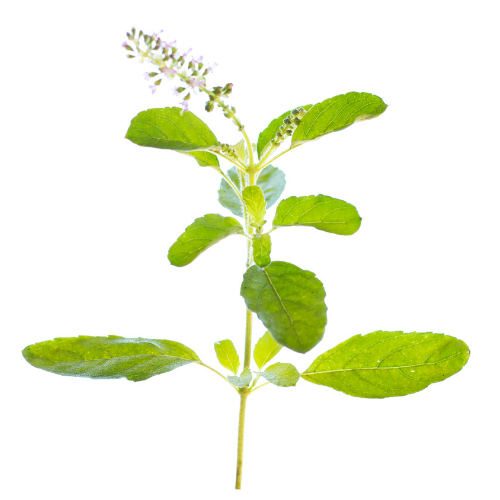
We love it for..
Anxiety Relief, Culinary Herb
Holy basil has always been considered to be a tonic, invigorating herb, useful for improving vitality.
Why We Love It
Holy basil, like sweet (culinary) basil, comes from India, where it is revered as the herb sacred to the goddess Lakshmi, wife of Vishnu, the god who preserves life. Tulsi means “matchless,” and the herb has very important medicinal properties—notably its ability to reduce blood- sugar levels. In Indian herbal medicine, holy basil has a wide range of uses, relieving fevers, bronchitis, asthma, stress, and mouth ulcers.
■ Ayurvedic remedy In Ayurvedic medicine, holy basil is chiefly employed for fevers. A classical Indian recipe mixes holy basil, black pepper (Piper nigrum, p. 250), ginger (Zingiber officinale, p. 155), and honey in a remedy that prevents infection and controls high fever.
■ Heart & stress Holy basil is thought to have an affinity with the heart, protecting it from stress and lowering blood pressure and cholesterol levels. It has a reputation for reducing stress and is regarded
as adaptogenic—helping the body to adapt to new demands and stresses.
■ Diabetic remedy The herb’s ability to help stabilize blood-sugar levels makes it useful in the treatment of diabetes.
■ Respiratory problems Holy basil is valuable for respiratory infections, especially colds, coughs, bronchitis, and pleurisy. It also treats asthma.
■ Other uses Juice is extracted and applied to insect bites, ringworm, and skin diseases. It is also used as ear drops for ear infections. Juice or powdered herb helps mouth ulcers to heal.
Research Resources
| Scientific Name | |
| Description | An aromatic annual growing to about 28 in (70 cm), with small, purple-red or white flowers. |
| Constituents | Volatile oil (1%) including eugenol (70–80%), Flavonoids (apigenin, luteolin), Triterpene (ursolic acid), Polyphenols, Saponins |
| Habitat & Cultivation | Holy basil is native to India and other tropical regions of Asia. It is also grown extensively in Central and South America, mainly for its medicinal properties. Holy basil can be grown from seed and is often cultivated as a potted plant. The aerial parts are picked before the flowers open, in early summer. |
| Parts Used | Aerial parts are tonic and invigorating and have a wide range of other properties. Leaves are serrated and covered in fine hairs |
| Key Actions | Antispasmodic, Analgesic, Lowers blood-sugar levels, Reduces fever, Adaptogenic, Anti-inflammatory |
| Cautions | Do not take during pregnancy. Do not take if trying to conceive. |
Clinical Studies
■ Diabetes Research into holy basil’s ability to reduce blood-sugar levels, and thus help diabetes, has been going on for some decades. It has now been established as a useful medicine for some types of diabetes.
■ Indian research Research in India has shown that holy basil helps lower blood pressure and has anti-inflammatory, pain-relieving, and fever-reducing properties. Preliminary research also indicates that the herb strengthens immune resistance, protects against radiation, has anticancer properties, and inhibits sperm production.